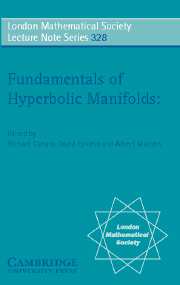Book contents
- Frontmatter
- Contents
- Preface
- Preface 2005
- PART I NOTES ON NOTES OF THURSTON
- A New Foreword
- Introduction to Part I
- Chapter 1.1 (G, X)-structures
- Chapter I.2 Hyperbolic structures
- Chapter I.3 Spaces of hyberbolic manifolds
- Chapter I.4 Laminations
- Chapter I.5 Pleated surfaces
- PART II CONVEX HULLS IN HYPERBOLIC SPACE, A THEOREM OF SULLIVAN, AND MEASURED PLEATED SURFACES
- PART III EARTHQUAKES IN 2-DIMENSIONAL HYPERBOLIC GEOMETRY
- PART IV LECTURES ON MEASURES ON LIMIT SETS OF KLEINIAN GROUPS
Chapter I.3 - Spaces of hyberbolic manifolds
Published online by Cambridge University Press: 05 November 2011
- Frontmatter
- Contents
- Preface
- Preface 2005
- PART I NOTES ON NOTES OF THURSTON
- A New Foreword
- Introduction to Part I
- Chapter 1.1 (G, X)-structures
- Chapter I.2 Hyperbolic structures
- Chapter I.3 Spaces of hyberbolic manifolds
- Chapter I.4 Laminations
- Chapter I.5 Pleated surfaces
- PART II CONVEX HULLS IN HYPERBOLIC SPACE, A THEOREM OF SULLIVAN, AND MEASURED PLEATED SURFACES
- PART III EARTHQUAKES IN 2-DIMENSIONAL HYPERBOLIC GEOMETRY
- PART IV LECTURES ON MEASURES ON LIMIT SETS OF KLEINIAN GROUPS
Summary
The geometric topology
We shall define a topology on the set of closed subsets of a topological space. We shall thereby derive topologies for both the space of complete hyperbolic manifolds and the space of geodesic laminations (see Section I.4.1 (Geodesic Laminations)). This topology was first considered by Chabauty (1950) as a topology on the space of closed subgroups of a locally compact topological group, and later by Harvey (1977) with specific reference to Fuchsian groups. See also Michael, (1951).
Definition. Given a topological space X, the Chabauty topology on C(X) (the set of all closed subsets of X) has a sub-basis given by sets of the following form:
(1) O1(K) = {A |A∩K = Ø} where K is compact;
(2) O2(U) = {A |A∩U ≠ Ø} where U is open.
If X is compact and metrizable, the Chabauty topology agrees with the topology induced by the Hausdorff metric. The Chabauty topology has the following nice topological properties.
Proposition: Properties of Chabauty topology. Let X be an arbitrary topological space (no particular assumptions), then:
(1) C(X) the set of closed subsets of X with the Chabauty topology is compact.
(2) If X is Hausdorff, locally compact and second countable, C(X) is separable and metrizable.
proof. (1) By Alexander's Sub-base theorem (Rudin, 1973, p. 368), we need only show that every covering by sub-basis elements has a finite sub-covering.
- Type
- Chapter
- Information
- Fundamentals of Hyperbolic ManifoldsSelected Expositions, pp. 59 - 75Publisher: Cambridge University PressPrint publication year: 2006

